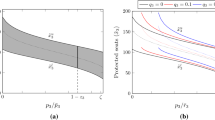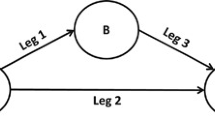Abstract
We study a single-resource multi-class revenue management problem where the resource consumption for each class is random and only revealed at departure. The model is motivated by cargo revenue management problems in the airline and other shipping industries. We study how random resource consumption distribution affects the optimal expected profit and identify a preference acceptance order on classes. For a special case where the resource consumption for each class follows the same distribution, we fully characterize the optimal control policy. We then propose two easily computable heuristics: (i) a class-independent heuristic through parameter scaling, and (ii) a decomposition heuristic that decomposes the dynamic programming formulation into a collection of one-dimensional problems. We conduct extensive numerical experiments to investigate the performance of the two heuristics and compared them with several widely studied heuristic policies. Our results show that both heuristics work very well, with class-independent heuristic slightly better between the two. In particular, they consistently outperform heuristics that ignore demand and/or resource consumption uncertainty. Our results demonstrate the importance of considering random resource consumption as another problem dimension in revenue management applications.



Similar content being viewed by others
Notes
According to a recent forecast report (Boeing, 2009), the world air cargo business, a 40-billion dollar industry worldwide, has been constantly growing at around 5% per year and is expected to triple in the next 20 years.
We assume the arrival probability for each customer class does not depend on t only for notational simplicity; all our results holds for non-stationary arrival probabilities.
References
Amaruchkul K, Cooper WL and Gupta D (2007). Single-leg air-cargo revenue management. Transportation Science 41 (4): 457.
Becker B and Dill N (2007). Managing the complexity of air cargo revenue management. Journal of Revenue & Pricing Management 6 (3): 175–187.
Billings JS, Diener AG and Yuen BB (2003). Cargo revenue optimisation. Journal of Revenue and Pricing Management 2 (1): 69–79.
Boeing (2009). World air cargo forecast 2008–2009, www.boeing.com/commercial/cargo/wacf.pdf.
Gupta D (2008). Flexible carrier-forwarder contracts for air cargo business. Journal of Revenue & Pricing Management 7 (4): 341–356.
Han DL, Tang LC and Huang HC (2010). A Markov model for single-leg air cargo revenue management under a bid-price policy. European Journal of Operational Research 200 (3): 800–811.
Huang K and Chang K (2010). An approximate algorithm for the two-dimensional air cargo revenue management problem. Transportation Research Part E: Logistics and Transportation Review 46 (3): 426–435.
Kasilingam RG (1997). Air cargo revenue management: Characteristics and complexities. European Journal of Operational Research 96 (1): 36–44.
Kleywegt AJ and Papastavrou JD (1998). The dynamic and stochastic knapsack problem. Operations Research 46 (1): 17–35.
Kleywegt AJ and Papastavrou JD (2001). The dynamic and stochastic knapsack problem with random sized items. Operations Research 49 (1): 26–41.
Lakehead (2009). Sample conference group booking contract, http://conferenceservices.lakeheadu.ca/sample-conference-group-booking-contract.
Lee TC and Hersh M (1993). A model for dynamic airline seat inventory control with multiple seat bookings. Transportation Science 27 (3): 252.
Liu Q and van Ryzin GJ (2008). On the choice-based linear programming model for network revenue management. Manufacturing & Service Operations Management 10 (2): 288–310.
Luo S, CakanyIldIrIm M and Kasilingam RG (2009). Two-dimensional cargo overbooking models. European Journal of Operational Research 197 (3): 862–883.
Moussawi L and Cakanyildirim M (2006). Profit maximization in air cargo overbooking. Working paper, 2005.
Papastavrou JD, Rajagopalan S and Kleywegt AJ (1996). The dynamic and stochastic knapsack problem with deadlines. Management Science 42 (12): 1706–1718.
Shaked M and Shanthikumar JG (1994). Stochastic Orders and their Applications: Probability and Mathematical Statistics. Academic Press: Boston, MA.
Slager B and Kapteijns L (2004). Implementation of cargo revenue management at KLM. Journal of Revenue and Pricing Management 3 (1): 80–90.
Subramanian J, Stidham S and Lautenbacher CJ (1999). Airline yield management with overbooking, cancellations, and no-shows. Transportation Science 33 (2): 147–167.
Van Slyke R and Young Y (2000). Finite horizon stochastic knapsacks with applications to yield management. Operations Research 48 (1): 155–172.
Xiao B and Yang W (2010). A revenue management model for products with two capacity dimensions. European Journal of Operational Research 205 (2): 412–421.
Zhuang W and Li MZF (2010). A new method of proving structural properties for certain class of stochastic dynamic control problems. Operations Research Letters 38 (5): 462–467.
Author information
Authors and Affiliations
Appendix
Appendix
Proof of Theorem 1
-
We only show the proof for convex order. The proof for usual stochastic order follows similarly. (a) We first show that v T+1(x̃)⩽v T+1(x) if Y x̃ ⩾ cx Y x . Note that

where the inequality follows from the facts that Y x̃ ⩾ cx Y x and h(·) is convex.
Assume that v t+1(x̃)⩽v t+1(x) if Y x̃ ⩾ cx Y x , and we need to show that v t (x̃)⩽v t (x). By (5), the key is to show that T k v t+1(x̃)⩽T k v t+1(x), ie,

Note that
 and
and  , thus
, thus  by the closure property of convex order and v
t+1(x̃+e
k
)⩽v
t+1(x+e
k
) by induction assumption. Therefore (A.1) holds true, ie, T
k
v
t+1(x̃)⩽T
k
v
t+1(x) given Y
x̃
>
cx
Y
x
. It follows that
by the closure property of convex order and v
t+1(x̃+e
k
)⩽v
t+1(x+e
k
) by induction assumption. Therefore (A.1) holds true, ie, T
k
v
t+1(x̃)⩽T
k
v
t+1(x) given Y
x̃
>
cx
Y
x
. It follows that
and we have shown that v t (x̃)⩽v t (x) if Y x̃ ⩾ cx Y x .
(b) The result follows from (a) immediately as Y x +A i ⩾ cx Y x +A j given A i ⩾ cx A j . Therefore, v t (x+e i )⩽v t (x+e j ) and Δ i v t (x)⩾Δ j v t (x).
(c) Suppose A i ⩾ cx A j and r j ⩾r i , that is, class-j is ranked higher than class-i. By (b), we have Δ i v t (x)⩾Δ j v t (x) if A i ⩾ cx A j . Therefore the result follows directly from

that is, if it is optimal to accept a class-i request at state (x, t), then it is also optimal to accept a class-j request which is ranked higher than class-i. □
Proof of Lemma 2
-
First we use coupling arguments to prove that the terminal function v T+1(x)=−E[h(Y x )] preserves submodularity for any nondecreasing and convex h(·).
Let f(x)=−v T+1(x) represent the penalty cost given the state x at period T+1. Submodularity of v T+1(x) is equivalent to

which says that the marginal cost of accepting a class-1 request at state x is lower than that of at state x+e 2. Consider two systems with system 1 at state x and system 2 at state x+e 2; and the arrival processes and random resource requirements of the two systems are coupled. We compare the marginal cost of accepting a class-1 request for the two systems. There are three cases: (1) both the total resource requirement of accepting a class-1 demand at state x and that of accepting another class-1 at state x+e 2 do not exceed the capacity; (2) the total resource requirement of accepting a class-1 demand at state x is within the capacity, while that of accepting a class-1 at state x+e 2 exceeds the capacity; (3) both have exceeded the capacity. In the first case, the marginal costs of system 1 and system 2 are the same; while in the second and third case, the marginal cost of system 1 is less than that of system 2 for the linear cost function. Therefore (A.2) is true and submodularity holds for v T+1(x).
Now assume that Δ1 v t+1(x 1, x 2)⩽Δ1 v t+1(x 1, x 2+1) and we need to show that submodularity holds for v t (x 1, x 2), which is essentially reduced to show that Δ1 T i v t+1(x 1, x 2)⩽Δ1 T i v t+1(x 1, x 2+1), i=1, 2. We will adopt an approach introduced by Zhuang and Li (Lemma 2, 2010) to prove the propagation of structural properties on the control operator T i .
(a) T 1 v t+1(x 1, x 2)−T 1 v t+1(x 1+1, x 2)⩽T 1 v t+1(x 1, x 2+1)−T 1 v t+1(x 1+1, x 2+1), ie,

Since

where the inequalities follow from submodularity of v t+1 (x 1, x 2) that

Therefore (A.3) holds true by Lemma 2 (Zhuang and Li, 2010).
(b) T 2 v t+1(x 1, x 2)−T 2 v t+1(x 1+1, x 2)⩽T 2 v t+1(x 1, x 2+1)−T 2 v t+1(x 1+1, x 2+1), ie,

Since

where the inequalities follow from submodularity of v t+1(x 1, x 2) that

hence (A.4) holds true. Therefore submodularity holds for v t (x 1, x 2), ie, Δ1 v t (x 1, x 2)⩽Δ1 v t (x 1, x 2+1). □
Proof of Theorem 2
-
The structure of the optimal control policy presented in Theorem 2 follows directly from the submodularity of v t (x 1, x 2), which is proved in Lemma 2. □
Proof of Lemma 3
-
(a) First we show that Δṽ T+1(x)⩽Δṽ T+1(x+1), ie,

Note that (A.5) is equivalent to

which is true since h(·) is convex. Hence, Δṽ T+1(x)⩽Δṽ T+1(x+1) holds. Assume that Δṽ t+1(x)⩽Δṽ t+1(x+1) and we need to show that Δṽ t (x)⩽Δṽ t (x+1). The key is to show that ΔT i ṽ t+1(x)⩽ΔT i ṽ t+1(x+1), where T i ṽ t+1(x)=max{ṽ t+1(x+1)+r i , ṽ t+1(x)}. That is,

which follows by

Therefore Δṽ t (x)⩽Δṽ t (x+1) holds by Lemma 2 (Zhuang and Li, 2010).
(b) Note that

where the last inequality follows by Δṽ t+1(x)⩽Δṽ t+1(x+1). □
Proof of Theorem 3
-
(a) Given that r i ⩾r j . By Δṽ t+1(S it *)>r i ⩾r j , it follows that S it *⩾S jt *.
(b) By Lemma 3(b), we have Δṽ t (S it *)⩾Δṽ t+1(S it *)>r i and it follows that S it *⩾S i,t−1 *. □
Proof of Lemma 4
-
The proof follows similar arguments as that of Lemma 3 and thus is omitted. □
Rights and permissions
About this article
Cite this article
Zhuang, W., Gumus, M. & Zhang, D. A single-resource revenue management problem with random resource consumptions. J Oper Res Soc 63, 1213–1227 (2012). https://doi.org/10.1057/jors.2011.129
Received:
Accepted:
Published:
Issue Date:
DOI: https://doi.org/10.1057/jors.2011.129







 and
and  , thus
, thus  by the closure property of convex order and v
t+1(x̃+e
k
)⩽v
t+1(x+e
k
) by induction assumption. Therefore (A.1) holds true, ie, T
k
v
t+1(x̃)⩽T
k
v
t+1(x) given Y
x̃
>
cx
Y
x
. It follows that
by the closure property of convex order and v
t+1(x̃+e
k
)⩽v
t+1(x+e
k
) by induction assumption. Therefore (A.1) holds true, ie, T
k
v
t+1(x̃)⩽T
k
v
t+1(x) given Y
x̃
>
cx
Y
x
. It follows that












